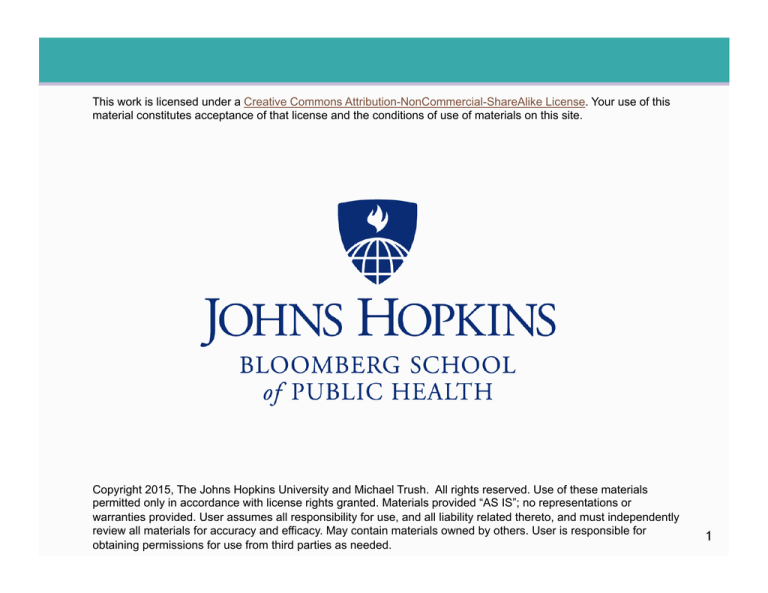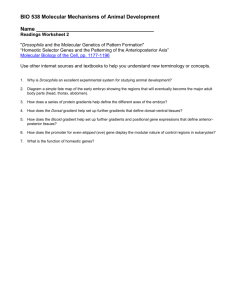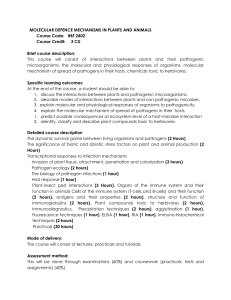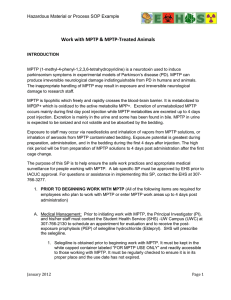
This work is licensed under a Creative Commons Attribution-NonCommercial-ShareAlike License. Your use of this
material constitutes acceptance of that license and the conditions of use of materials on this site.
Copyright 2015, The Johns Hopkins University and Michael Trush. All rights reserved. Use of these materials
permitted only in accordance with license rights granted. Materials provided “AS IS”; no representations or
warranties provided. User assumes all responsibility for use, and all liability related thereto, and must independently
review all materials for accuracy and efficacy. May contain materials owned by others. User is responsible for
obtaining permissions for use from third parties as needed.
1
Toxicokinetics: Absorption, Distribution,
and Excretion
Michael A. Trush, PhD
Johns Hopkins University
Section A
How Do Chemicals Reach Their Molecular Target?
The material in this video is subject to the copyright of the owners of the material and is being provided for educational purposes under
rules of fair use for registered students in this course only. No additional copies of the copyrighted work may be made or distributed.
Toxic Action and Toxic Effect
! The toxic action of a chemical is a consequence of the physical/
chemical interaction of the active form of that chemical with a
molecular target within the living organism
! The magnitude of the toxic effect will be a function of the
concentration of altered molecular targets
- This is related to the concentration of the active form of the
toxicant( biologically effective dose) at the site where the
molecular targets are located
4
Xenobiotics Cross Membranes to Reach Targets
5
How Do Chemicals Cross Membranes?
! ! The absorption, distribution, and excretion of xenobiotics involves
them passing through various cell and organ membranes
This occurs through various transport mechanisms
6
Factors Affecting Membrane Transport of Chemicals
! Molecular weight/shape
! Charge
! Lipid solubility
! Membrane composition
! Membrane thickness
7
Transport Mechanisms
! Simple diffusion
! Facilitated diffusion (passive mediated)
! Active transport
! Pinocytosis/receptor-mediated uptake
! Filtration
8
Different Types of Transport
9
Characteristics of Simple Diffusion
! Transport proceeds in the direction of the electrochemical potential
(concentration) gradient—unionized form
! Transport is not saturable even at high concentration gradients
! No structural specificity
! No energy requirement
! Inherently symmetrical transport
10
Carrier Proteins
! Both passive-mediated (facilitated) and active-mediated transport
involve the use of carrier proteins
11
Characteristics of Facilitated Transport
! Transport proceeds in the direction of the electrochemical potential
(concentration) gradient
! The process is saturable at high concentration gradients
- That is, there is a maximum rate of transport
! Structural specificity (specific inhibitors)
! No energy requirements
! Inherently symmetrical transport
12
Characteristics of Active-Mediated Transport
! Transport can proceed against an electrochemical potential
(concentration) gradient
! The process is saturable at high concentration gradients
! Structural specificity
! Requires cellular energy
! Asymmetrical transport
13
Examples: Chemical Toxicity and Active Transport
! The herbicide paraquat, which targets alveolar type II cells in the
lung
! MPTP toxicity results in Parkinson’s disease
- A result of being selectively toxic to dopamine neurons in the
substantia nigra of the brain
- MPTP is metabolized to MPP+ in the CNS
- MPP+ is taken up and accumulates in dopamine neurons
14
Transport and Toxicity of MPTP
This image has been removed due to copyright.
15
Pinocytosis and Phagocytosis
16
Filtration
! Transport of solutes (dissolved materials) as a consequence of bulk
flow of fluid (aqueous) phase
! Glomerulus of kidney is a good example of a major site where
filtration occurs
17






